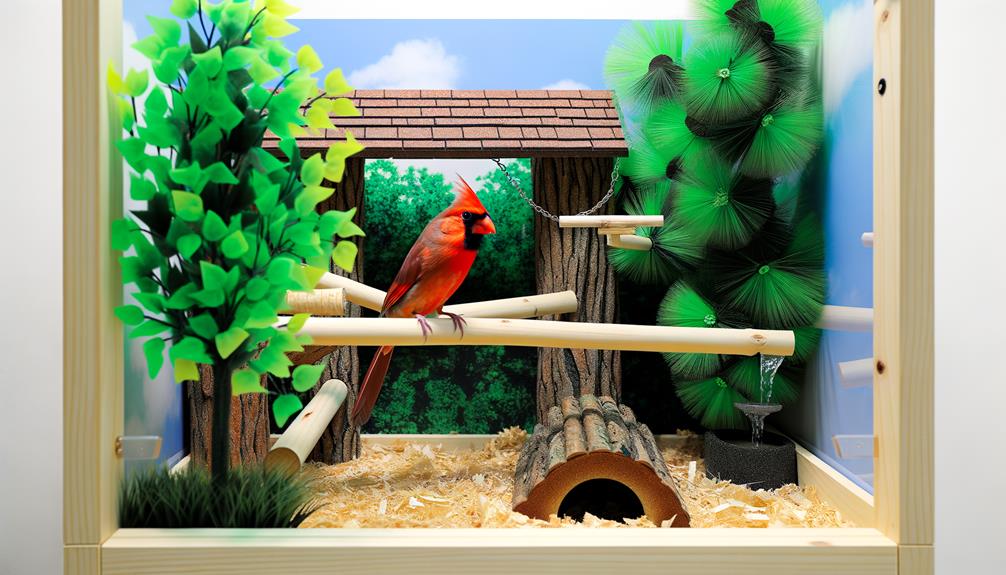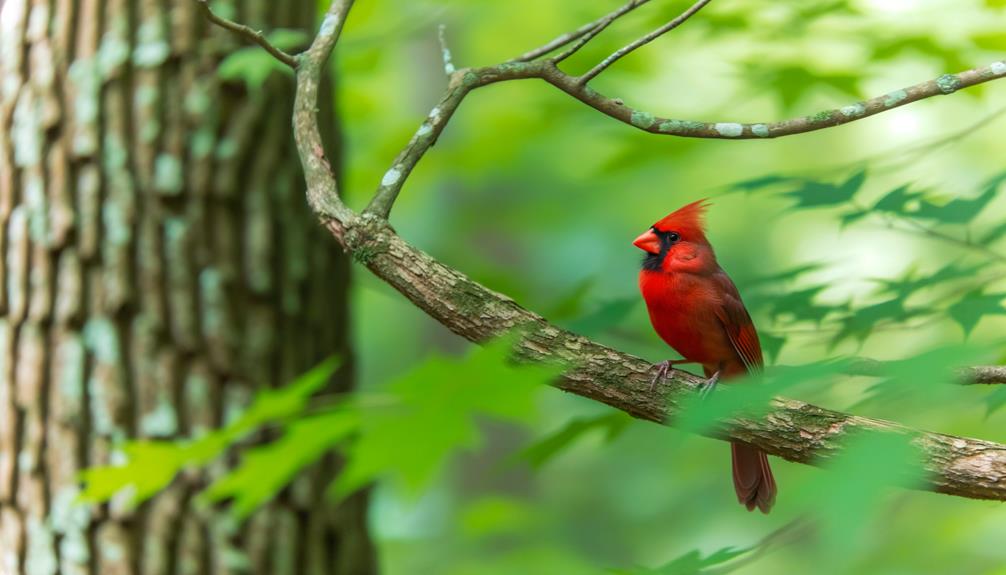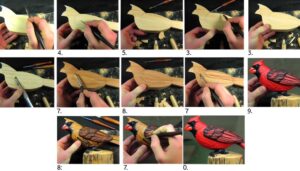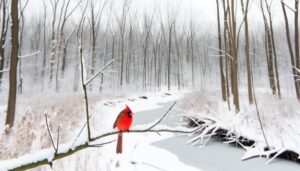Can Northern Cardinals Be Jept as Pets? Need to Know!
Northern Cardinals cannot be kept as pets due to protections under the Migratory Bird Treaty Act, making it illegal without a special permit. Capturing or domesticating wild cardinals disrupts their natural behaviors and habitats, causing stress and behavioral changes.
These birds require diverse habitats, proper flight space, and a diet of seeds, fruits, and insects, which are hard to replicate in captivity. Additionally, their strong territorial instincts and complex social interactions demand conditions that mimic their natural environment.
By attracting cardinals to backyard feeders, enthusiasts can enjoy their presence while respecting legal and ethical guidelines. Learn more about creating a cardinal-friendly space.

Key Takeaways
- Northern Cardinals are protected by the Migratory Bird Treaty Act, making it illegal to keep them as pets without a special permit.
- Captivity disrupts cardinals’ natural behaviors, causing stress and adverse behavioral changes.
- Meeting cardinals’ complex dietary and ecological needs in captivity is challenging and often inadequate.
- Removing wild cardinals from their habitats disrupts ecosystems and damages local biodiversity.
- Legal penalties, including fines, are imposed for capturing or keeping Northern Cardinals without appropriate authorization.
5 Aspects of Northern Cardinals as Pets
| Aspect | Details |
|---|---|
| Legal Status | Keeping Northern Cardinals as pets is illegal in the U.S. due to the Migratory Bird Treaty Act. |
| Ethical Concerns | Capturing wild birds disrupts ecosystems and may cause harm to the species. |
| Care Requirements | Cardinals require spacious enclosures, specific diets (insects, fruits, seeds), and regular stimulation. |
| Lifespan in Captivity | If kept illegally, lifespan may be reduced due to inadequate care and stress. |
| Alternative Options | Consider bird-watching, installing feeders, or supporting conservation efforts instead. |
Legal Considerations

Before considering a Northern Cardinal as a pet, it’s important to understand that these birds are protected by the Migratory Bird Treaty Act, which makes it illegal to capture, sell, or keep them without a special permit. This federal law aims to conserve migratory bird species by regulating activities that could harm their populations.
Permits are typically granted only for scientific research, education, or rehabilitation purposes. Violating this act can result in significant fines and legal penalties. Additionally, individual states may have additional regulations that reinforce federal protections.
As a result, anyone interested in keeping a Northern Cardinal must thoroughly research and comply with both federal and state laws to avoid legal repercussions and contribute to the species’ conservation.
Ethical Concerns
Keeping Northern Cardinals as pets raises significant ethical concerns, as it disrupts their natural behaviors and habitats, potentially leading to stress and a decline in their well-being.
These birds thrive in their natural environments, where they engage in complex social interactions and exhibit instinctive behaviors. Captivity can severely limit these innate activities, causing a range of issues.
- Stress and Anxiety: Captive conditions can induce chronic stress, adversely affecting their health.
- Behavioral Changes: Lack of natural stimuli can result in abnormal behaviors and psychological distress.
- Conservation Impact: Removing wild cardinals disrupts local ecosystems and can lead to population declines.
- Ethical Responsibility: Humans have a duty to respect wildlife and avoid practices that harm their natural states.
Understanding these concerns is essential for making informed decisions.
Habitat Requirements

Given the ethical concerns surrounding the captivity of Northern Cardinals, understanding their specific habitat requirements in the wild underscores why they are ill-suited for life as pets. Northern Cardinals thrive in diverse environments ranging from woodlands to gardens. They require ample foliage for nesting, food sources like seeds and insects, and open spaces for flight. Replicating these conditions in captivity is challenging and often inadequate.
| Requirement | Wild Environment | Captive Challenges |
|---|---|---|
| Nesting Foliage | Dense shrubs, trees | Limited indoor vegetation |
| Food Sources | Seeds, insects | Restricted diet in captivity |
| Space for Flight | Open areas, forests | Confined aviary environments |
These complex habitat needs highlight the difficulties in meeting their ecological requirements outside their natural settings.
Dietary Needs
Northern Cardinals primarily consume seeds, fruits, and insects in their natural habitats.
To maintain their health in captivity, they need a balanced diet that replicates these natural food sources and includes essential nutritional supplements.
Proper dietary management guarantees their overall well-being and longevity.
Natural Food Sources
A typical diet for Northern Cardinals in the wild consists of seeds, fruits, and insects, providing essential nutrients for their survival. These food sources offer a balanced intake of proteins, fats, and carbohydrates, vital for their overall health.
Northern Cardinals mainly forage for:
- Seeds: Sunflower, safflower, and millet seeds are favored.
- Fruits: Berries such as raspberries, dogwood, and grapes.
- Insects: Beetles, grasshoppers, and caterpillars.
- Grains: Small grains like cracked corn and oats.
Each component in their diet serves a specific function, from energy provision to aiding in reproduction and feather maintenance. This diverse diet allows them to thrive in their natural habitat and maintain their vibrant plumage and robust health.
Understanding these dietary habits can help in providing a suitable environment for them.
Nutritional Supplements Required
To guarantee Northern Cardinals receive all necessary nutrients in captivity, one must consider incorporating specific nutritional supplements that mimic their diverse natural diet. These vibrant birds require a balanced intake of vitamins, minerals, and proteins to maintain their health and coloration. Supplementation can include commercial bird vitamins, calcium sources, and protein-rich foods like mealworms. Consistent monitoring and adjustment of their diet help ensure optimal health.
| Supplement Type | Purpose | Example Sources |
|---|---|---|
| Vitamins | Boost immune system | Commercial bird vitamins |
| Calcium | Bone health and egg production | Cuttlebone, crushed eggshells |
| Proteins | Muscle development | Mealworms, insects |
| Omega-3 Fatty Acids | Feather health | Flaxseed, fish oil |
Proper supplementation replicates their natural dietary diversity, promoting longevity and vibrancy.
Behavioral Traits

In examining the behavioral traits of Northern Cardinals, one observes their strong territorial instincts and vibrant social interactions. These birds are known for their fiercely defended territories, often engaging in vocal displays and physical confrontations to ward off intruders.
Socially, Northern Cardinals exhibit complex dynamics, engaging in various behaviors such as:
- Mating rituals: Elaborate courtship displays and feeding behaviors.
- Parenting: Both males and females participate in nest building and chick-rearing.
- Communication: A wide range of vocalizations used for different purposes, including alarm calls and mate attraction.
- Seasonal changes: Behavioral adaptations to differing seasonal conditions.
Understanding these traits is pivotal for determining their suitability as pets, as their natural behaviors may be challenging to replicate in a domestic environment.
Health and Longevity
Evaluating the health and longevity of Northern Cardinals in captivity requires a thorough understanding of their dietary needs, susceptibility to diseases, and environmental stressors. These birds thrive on a diet rich in seeds, fruits, and insects. Nutritional deficits can lead to weakened immune systems and shorter lifespans. Captive environments should mimic their natural habitat to reduce stress, which can manifest as feather plucking or reduced activity. Common diseases include avian pox and bacterial infections, both of which require prompt medical attention.
| Factor | Impact on Health and Longevity |
|---|---|
| Diet | Nutritional balance is vital |
| Disease Susceptibility | Increased risk in captivity |
| Environmental Stress | Can lead to behavioral issues |
| Veterinary Care | Essential for disease management |
| Habitat Conditions | Should mimic natural environment |
Understanding these factors is necessary for anyone considering keeping a Northern Cardinal as a pet.
Alternatives to Pet Ownership

For those interested in Northern Cardinals without the commitment of pet ownership, bird watching offers a compelling alternative.
Installing backyard bird feeders can attract these vibrant birds, providing opportunities for observation and study in a natural setting.
This approach promotes the well-being of the cardinals while allowing enthusiasts to enjoy their presence.
Bird Watching Opportunities
Bird watching offers a rewarding alternative to pet ownership, providing opportunities to observe Northern Cardinals in their natural habitat. This activity allows enthusiasts to appreciate the birds’ behaviors, mating rituals, and vibrant plumage without disrupting their natural ecosystem.
Key aspects of bird watching include:
- Location: Identifying habitats such as woodlands, gardens, and parks.
- Timing: Early morning hours when cardinals are most active.
- Equipment: Utilizing binoculars and field guides for better observation.
- Documentation: Keeping detailed records of sightings for scientific and personal interest.
Engaging in bird watching fosters a deeper understanding of avian ecology and promotes conservation efforts. It also provides a fulfilling way to connect with nature, enhancing one’s appreciation for wildlife.
Backyard Bird Feeders
Regularly setting up backyard bird feeders can attract Northern Cardinals, offering a convenient and ethical way to enjoy these vibrant birds up close. These feeders provide a reliable food source, which is particularly beneficial during colder months when natural resources are scarce. Cardinals are attracted to feeders filled with sunflower seeds, safflower seeds, and peanuts.
Additionally, the placement and maintenance of feeders play essential roles. Positioning feeders near shrubs or trees ensures a safe environment for cardinals, allowing them to retreat quickly if threatened. Cleaning feeders regularly prevents the spread of diseases among bird populations.
| Feeder Type | Preferred Food | Ideal Placement |
|---|---|---|
| Tube Feeder | Sunflower Seeds | Near Shrubs |
| Platform Feeder | Safflower Seeds | Tree Vicinity |
| Suet Feeder | Peanuts | Sheltered Areas |
Why does the Northern Cardinal Survive in the Northeast
The northern cardinal survives and thrives in the Northeast due to several key adaptations and traits that allow it to handle the region’s varied climate, including cold winters and warm summers:
1. Year-Round Resident:
Northern cardinals are non-migratory birds, meaning they remain in the Northeast throughout the year, even during the harsh winter months. Their ability to survive cold weather is due in part to their thick plumage, which helps insulate them from the cold.
2. Adaptability to Habitat:
Cardinals are highly adaptable to various habitats, including forests, suburban areas, gardens, and parks. In the Northeast, they can find suitable nesting and feeding sites in a wide range of environments, from rural woodlands to urban neighborhoods with bird feeders.
3. Dietary Flexibility:
Cardinals have a varied diet that includes seeds, fruits, and insects. In the winter, when insects are scarce, they rely heavily on seeds and berries. Bird feeders in suburban areas provide an additional food source during the cold months, which is a key factor in their survival in the Northeast.
4. Social and Territorial Behavior:
Cardinals are territorial and often maintain a well-defined range where they find food and shelter. Their social behavior also includes foraging in pairs or small groups, which can improve their ability to locate food, especially during the colder months when resources are more limited.
5. Foraging and Storing Food:
During fall and winter, cardinals are adept at finding and storing food like seeds and nuts. This behavior helps them build reserves for when food is scarcer, aiding their survival during periods when snow or ice may cover their primary food sources.
6. Shelter and Nesting:
Northern cardinals build their nests in dense shrubs or trees, which offer protection from predators and harsh weather. During winter, they take refuge in thick vegetation or evergreen trees, which provide cover from the wind and cold.
7. Bird Feeders:
In suburban and rural areas, humans play a role in helping cardinals survive by providing bird feeders filled with seeds, such as sunflower seeds, which are a favorite of cardinals. This artificial food source helps sustain them during the winter months when natural food sources are less available.
8. Cold Weather Adaptation:
Cardinals have physiological adaptations that help them conserve energy during the cold. They fluff up their feathers to trap warm air close to their bodies, and their metabolism adjusts to the colder temperatures, allowing them to survive with less food in the winter.
Together, these factors make the northern cardinal well-suited for the Northeast, allowing them to thrive despite the region’s challenging winter conditions.
Conclusion
To sum up, Northern cardinals shouldn’t be kept as pets due to numerous legal and ethical concerns. Their specialized habitat and dietary needs are challenging to replicate, and their behavioral traits can make captivity stressful.
While these vibrant birds are a joy to observe in the wild, keeping one as a pet would be like trying to cage a rainbow—impossible and unwise.
Instead, consider alternatives like birdwatching or supporting local conservation efforts to appreciate these stunning creatures.






